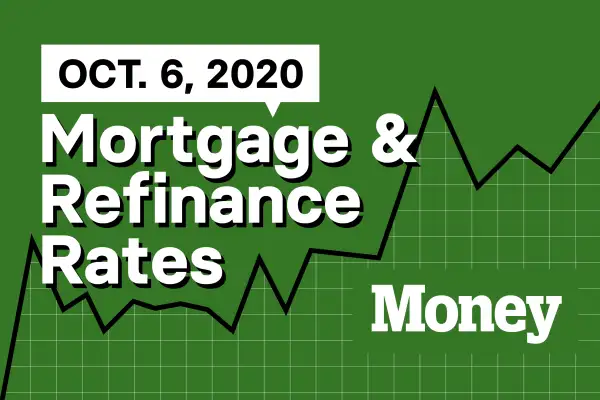Here Are Today's Best Mortgage & Refinance Rates for October 6, 2020

The average rate for a 30-year fixed-rate purchase mortgage was 3.436% Monday. The average rate for a 30-year refinance was 4.326%.
Money's current mortgage rates include data from 8,000 lenders across the United States and are updated daily. The rates include points and represent what a borrower with a 20% down payment and 700 credit scores — roughly the national average FICO score — would have been quoted.
| 30-year fixed-rate purchase mortgage |
| 3.436% |
| Rate of October 5, 2020 |
Mortgage rates vary from state to state. On Monday, borrowers in Alaska were quoted the lowest mortgage rates — at 3.239%. People looking for mortgages in Texas saw the highest average rate at 3.653%. Nationwide, borrowers with the highest credit scores, 740 and above, were quoted rates averaging 2.984%, while those with credit of 640 or below were shown rates of 4.735% — a 1.751 percentage-point spread.
You may be able to negotiate a lower rate if you shop around or if you have other accounts with the lender. (Money's picks for the best mortgage lenders are here.) Currently, some banks are hiking up advertised rates to keep demand in check, so you may be offered a lower rate if you reach out directly.
Freddie Mac's widely quoted Primary Mortgage Market Survey put rates at 2.88% with 0.8 points paid for the week ending October 1. The mortgage purchaser's weekly survey reflects borrowers who put 20% down on conforming loans and have excellent credit.
Refinance rates today
Money's survey also shows that the offered rate for a 30-year refinance for someone with a 740 credit score was 3.64% on Monday. Last October, the average mortgage rate (including fees) was 3.859%.
| 30-year fixed-rate mortgage refi |
| 3.64% |
| Rate of October 5, 2020 |
A homeowner with a $200,000 mortgage balance currently paying 3.859% on a 30-year loan could potentially cut their monthly payment from $939 to $914 by financing at the current lower rates. To determine if it's worth it to refinance your mortgage, also consider the closing fees you paid on your current mortgage, how much your new lender is charging and how long you have left on your loan term. (Our picks for the best lenders for refinancing are here).
What else is happening in the housing market right now?
Home prices were up 5.9% year-over-year during the month of August, according to CoreLogic's Home Price Index. It is the highest annual growth since June of 2018 and represents an escalation over the 5.1% pace of growth achieved in July.
Mortgage rates have stayed close to record lows and have kept home buyer demand high despite the economic pressure of the COVID-19 pandemic. The continued demand has outpaced supply growth and there are 17% fewer homes for sale than in August 2019.
“Consumers who have not been as financially impacted by the ongoing economic pressures are taking advantage of low mortgage rates to either break into the market, upgrade their living situations or purchase second homes and investment properties,” said Frank Martell, CEO of CoreLogic. “With heightened activity putting a strain on the current for-sale inventory, strong demand should help spur new home-building activity.”
CoreLogic is forecasting a slow-down in home prices growth as new inventory starts to come onto the market in 2021, with prices starting to decrease early in the year and reach a growth rate of 0.2% by August.
Elsewhere, the number of mortgages in forbearance plans continues its slow decline, decreasing 6 basis points from 6.87% to 6.81% for the week ending September 27, according to the Mortgage Bankers Association. The share of Fannie Mae and Freddie Mac loans in the payment deferral plans decreased for the 17th week in a row, with portfolio and private-label securities loans also down. Ginnie Mae loans are on the uptick, however, increasing 1 basis point to 9.16%.
"As of the end of September, there continues to be a slow and steady decrease in the share of loans in forbearance — driven by consistent declines in the GSE loan share — and a persistently high amount in the Ginnie Mae portfolio," said Mike Fratantoni, MBA's Chief Economist. "The significant churn in the labor market now, more than six months into the pandemic, is still causing financial distress for millions of homeowners. As a result, more than 70 percent of loans in forbearance are now in an extension."
Mortgage Prediction of the Week
Expert views on what comes next.
Ryan Schneider, chief executive officer of Realogy, a real estate services provider, on how recent societal changes will continue to drive demand:
Real estate’s recent momentum is not a blip on the radar. For the remainder of this year, we expect the ongoing effects of the pandemic to propel a housing evolution, driven by fundamental societal shifts in Americans’ perspectives on both homebuying and the home itself. The pandemic fast-tracked virtual advancements in homebuying that made the process not only safer but also, in many ways, more convenient. At the same time, we’re seeing Americans simply more willing to move."
For more information on housing demand, read: Everyone Wants to Buy a House Right Now. 9 Experts Predict How Long Demand Will Soar
Procrastinators, It's Not Too Late to Refinance Your Mortgage and Save Thousands
Everyone Wants to Buy a House Right Now. 9 Experts Predict How Long Demand Will Soar
Home Equity Is Soaring — if You're Tempted to Borrow Against Your Home, Read This First
